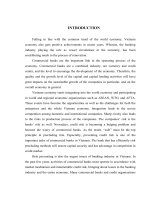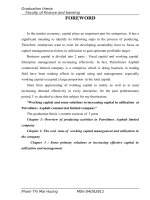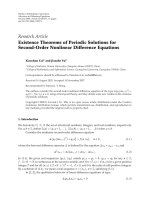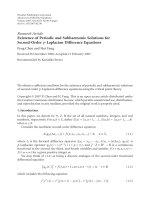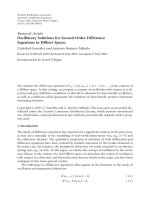NONOSCILLATORY HALF-LINEAR DIFFERENCE EQUATIONS AND RECESSIVE SOLUTIONS ˇ ´ MARIELLA CECCHI, pdf
Bạn đang xem bản rút gọn của tài liệu. Xem và tải ngay bản đầy đủ của tài liệu tại đây (553.07 KB, 12 trang )
NONOSCILLATORY HALF-LINEAR DIFFERENCE
EQUATIONS AND RECESSIVE SOLUTIONS
MARIELLA CECCHI, ZUZANA DO
ˇ
SL
´
A, AND MAURO MARINI
Received 30 January 2004 and in revised form 26 May 2004
Recessive and dominant solutions for the nonoscillatory half-linear difference equation
are investigated. By using a uniqueness result for the zero-convergent solutions satisfying
a suitable final condition, we prove that recessive solutions are the “smallest solutions in a
neighborhood of infinity,” like in the linear case. Other asymptotic properties of recessive
and dominant solutions are treated too.
1. Introduction
Consider the second-order half-linear difference equation
∆
a
n
Φ
∆x
n
+ b
n
Φ
x
n+1
= 0, (1.1)
where ∆ is the forward difference operator ∆x
n
= x
n+1
− x
n
, Φ(u) =|u|
p−2
u with p>1,
and a ={a
n
}, b ={b
n
} are positive real sequences for n ≥ 1.
It is known that there is a surprising similarity between (1.1) and the linear difference
equation
∆
a
n
∆x
n
+ b
n
x
n+1
= 0. (1.2)
In particular, for (1.1), the Sturmian theory continues to hold (see, e.g., [15]), and also
Kneser- or Hille-type oscillation and nonoscillation criteria can be formulated (see, e.g.,
[10]).
Another concept recently extended to the half-linear case is the concept of a reces-
sive solution (see [11]). We recall (see, e.g., [1, 8, 14]) that in the linear case, if (1.2)is
nonoscillatory, then there exists a nontrivial solution u
={u
n
}, uniquely determined up
to a constant factor, such that
lim
n
u
n
x
n
= 0, (1.3)
where x ={x
n
} denotes an arbitrary nontrivial solution of (1.2), linearly independent of
u.Solutionu is called a recessive solution and x a dominant solution. B oth solutions play
Copyright © 2005 Hindawi Publishing Corporation
Advances in Difference Equations 2005:2 (2005) 193–204
DOI: 10.1155/ADE.2005.193
194 Recessive solutions for half-linear equations
an important role in different contexts (see, e.g., [1, 4, 6] and references therein). In the
linear case (see, e.g., [1, Chapter 6.3], [3, Theorem 6.8], [8, 14]), recessive solutions u and
dominant solutions x can be equivalently characterized by the properties
∞
1
a
n
u
n
u
n+1
=∞,
∞
1
a
n
x
n
x
n+1
< ∞, (1.4)
∆u
n
u
n
<
∆x
n
x
n
for large n. (1.5)
As mentioned above, the concept of a recessive solution has been extended in [11]to
the nonoscillatory half-linear equation (1.1) by the following way. Consider the general-
ized Riccati equation
∆w
n
− b
n
+
1 −
a
n
Φ
Φ
∗
a
n
+ Φ
∗
w
n
w
n
= 0, (1.6)
where Φ
∗
denotes the inverse function of Φ.If(1.1) is nonoscillatory, in [11]itisproved
that there exists a solution w
∞
={w
∞
n
} of (1.6), such that a
n
+ w
∞
n
> 0forlargen,with
the property that for any other solution w ={w
n
} of (1.6), with a
n
+ w
n
> 0insome
neighborhood of ∞,
w
∞
n
<w
n
for large n. (1.7)
Such solution w
∞
is called (eventually) a minimal solution of (1.6) and the solution u =
{u
n
} of (1.1), given by
∆u
n
= Φ
∗
w
∞
n
a
n
u
n
, (1.8)
is called a recessive solution of (1.1). Since (1.1) is nonoscillatory, for any solution x ={x
n
}
of (1.1), the sequence w
x
={w
x
n
},where
w
x
n
=
a
n
Φ
∆x
n
Φ
x
n
, (1.9)
is, for large n, a solution of the generalized Riccati equation (1.6)andsoproperty(1.7)
coincides with (1.5), stated in the linear case.
In [11], the open problems whether analogous results as the limit characterization
(1.3) and the summation property (1.4) hold in the half-linear case have been also posed.
In the case when b is eventually negative, a complete answer to both questions has been
given by the authors in a recent paper [6].
Our aim here is to continue this study, by considering the case when b
n
is positive and
∞
n=1
b
n
Φ
∞
j=n+1
1
Φ
∗
a
j
< ∞. (1.10)
We will give a positive answer to the question posed in [11] concerning the limit char-
acterization of the recessive solution, by show ing that properties (1.3)and(1.5)areequiv-
alent also in the half-linear case. In addition, two summation criteria, which reduce to
Mariella Cecchi et al. 195
(1.4) in the linear case, are proved. These results are useful also in the numerical com-
putation of recessive solutions. Indeed, as pointed out in [4, Chapter 5], the recessive
behavior can be easily destroyed by numerical errors.
A similar problem has been studied and completely solved in [7] for the half-linear
differential equations
a(t)Φ(x
)
+ b(t)Φ(x) = 0, (1.11)
where a, b are continuous positive functions for t ≥ 0, without any additional condition.
One of the tools used in [7] for proving limit and integral characterization of principal
solutions is based on certain properties of a suitable quadratic functional studied in [9].
Since in the discrete case such properties are not known, a di fferent approach is used here
and the additional condition (1.10)isrequired.
A discussion concerning the role of (1.10) and open problems completes the paper.
2. Preliminaries
Throughout the paper, for brevity, by “solution of (1.1)” we mean a nontrivial solution
of (1.1). A solution x ={x
n
} of (1.1)issaidtobenonoscillatory if there exists N
x
≥ 1
such that x
n
x
n+1
> 0forn ≥ N
x
. Since, as claimed, the Sturm-type separation theorem
holds for (1.1), a solution of (1.1) is nonoscillatory if and only if every solution of (1.1)is
nonoscillatory. Hence, (1.1)iscallednonoscillatory if its solutions are nonoscillatory.
The half-linear equation is characterized by the homogeneity property, which means
that if x
={x
n
} is a solution of (1.1), then also λx is a solution for any constant λ. This
property will be used in our later consideration.
Let x ={x
n
} be a solution of (1.1) and denote its quasi-difference with x
[1]
={x
[1]
n
},
x
[1]
n
= a
n
Φ(∆x
n
). Observe that from (1.10), it follows that
∞
n=1
1
Φ
∗
a
n
< ∞. (2.1)
Under assumption (1.10), equation (1.1) is nonoscillatory, as the following result
shows.
Lemma 2.1. If condition (1.10)issatisfied,then(1.1) is nonoscillatory. More precis ely, if
(1.10) holds, then (1.1) has a (nonoscillatory) solution u ={u
n
} satisfying
lim
n
u
n
= 0, lim
n
u
[1]
n
= c
u
, c
u
∈ R \{0}. (2.2)
Lemma 2.1 can be obtained from existing results. For instance it follows, with minor
changes, from [13, 16], in which the same conclusion has been proved for systems, or
equations, with delay. In particular in [16, Theorem 4.2], some additional assumptions on
superlinearity are required. For the sake of completeness, a sketch of the proof is provided
here.
196 Recessive solutions for half-linear equations
Proof (sketch). Choose n
0
large so that
∞
k=n
0
b
k
Φ
∞
j=k+1
1
Φ
∗
a
j
<
1
2
. (2.3)
Consider the Banach space B
∞
n
0
of all converging sequences defined for every integer n ≥
n
0
, endowed with the topology of the supremum norm, and consider the set Ω ⊂ B
∞
n
0
given by
Ω =
u =
u
n
∈ B
∞
n
0
:
1
2
∞
j=n
1
Φ
∗
a
j
≤ u
n
≤
∞
j=n
1
Φ
∗
a
j
, n ≥ n
0
. (2.4)
Consider the operator ᐀ : Ω → B
∞
n
0
defined by ᐀(u) = y ={y
n
},where
y
n
=
∞
k=n
1
Φ
∗
a
k
Φ
∗
− 1+
∞
i=k
b
i
Φ
u
i+1
. (2.5)
It is easy to show that ᐀(Ω) ⊂ Ω. Using the discrete version of a well-known compactness
result by Avramescu (see, e.g., [2, Remark 3.3.1]), one can check that ᐀(Ω)isrelatively
compact in B
∞
n
0
. Because ᐀ is also continuous in Ω, by the Schauder fixed-point theorem,
there exists a fixed point u ={u
n
} of the operator ᐀ in Ω. Finally we have lim
n
u
n
= 0and
lim
n
u
[1]
n
= 0, that is, the assertion.
The next lemma states the possible types of all nonoscillatory solutions of (1.1).
Lemma 2.2. Assume (1.10)andletx ={x
n
} be a solution of (1.1). Then
(i) x and its quasi-difference x
[1]
are eventually strongly monotone;
(ii) x is bounded;
(iii) if lim
n
x
n
= 0, then lim
n
x
[1]
n
= µ
x
,where−∞ ≤ µ
x
< 0 or 0 <µ
x
≤∞according to
whether x
n
> 0 or x
n
< 0 for large n,respectively.
Proof. Without loss of generality, assume that x
n
> 0forn ≥ n
0
≥ 1.
Claim (i). From (1.1), the quasi-difference x
[1]
is eventually decreasing and so {∆x
n
} has
eventually a fixed sign (different from zero), that is, x is e ventually strongly monotone.
Since for large n we have ∆x
[1]
n
< 0, x
[1]
is strongly monotone too.
Claim (ii). Since x
[1]
is eventually decreasing, we have for n ≥ n
0
,
∆x
n
≤ Φ
∗
x
[1]
n
0
1
Φ
∗
a
n
; (2.6)
by summation from n
0
to n,weobtain
x
n+1
≤ x
n
0
+ Φ
∗
x
[1]
n
0
n
k=n
0
1
Φ
∗
a
k
. (2.7)
If x is unbounded, in view of (2.1), inequality (2.7) gives a contradiction as n →∞.
Mariella Cecchi et al. 197
Claim (iii). Since x is eventually strongly monotone, positive and lim
n
x
n
= 0, x is even-
tually decreasing and so ∆x
n
< 0forlargen.Iflim
n
x
[1]
n
= 0, then, by summation of (1.1)
from n to ∞,weobtainx
[1]
n
> 0forlargen, which is a contradiction.
We close this section with the following version of the discrete Gronwall inequality.
Lemma 2.3. Let z,w be two nonnegative sequences for n
≥ N ≥ 1 such that
∞
j=N
w
j
z
j+1
< ∞
and
∞
j=N
w
j
< ∞.Ifforn ≥ N,
z
n
≤
∞
j=n
w
j
z
j+1
, (2.8)
then z
n
= 0 for every n ≥ N.
Proof. Define the sequence v ={v
n
} as follows:
v
n
=
∞
j=n
w
j
z
j+1
. (2.9)
In view of (2.8), we have z
n
≤ v
n
for n ≥ N.Then∆v
n
=−w
n
z
n+1
≥−w
n
v
n+1
or
∆v
n
+ w
n
v
n+1
≥ 0. (2.10)
Since w
n
≥ 0and
∞
n=N
w
n
< ∞,wehave0<
∞
j=N
(1 + w
j
)
−1
< ∞.Putting
h
n
=
∞
j=n
1
1+w
j
, (2.11)
we have h
n
> 0and∆h
n
= h
n
w
n
.Multiplying(2.10)byh
n
,weobtain(n ≥ N)
h
n
∆v
n
+ h
n
w
n
v
n+1
= h
n
∆v
n
+ ∆h
n
v
n+1
= ∆
h
n
v
n
≥ 0. (2.12)
Since lim
n
v
n
= 0and{h
n
} is bounded, from (2.12)wehaveh
n
v
n
≤ 0andsov
n
= 0.
3. Recessive and dominant solutions
As already claimed, in [11] the notion of a recessive solution has been extended by using
the Riccati equation approach, and for (1.1)readsasfollows.
Definit ion 3.1. Asolutionu
={u
n
} of (1.1)issaidtobearecessive solution of (1.1)iffor
every nontrivial solution x ={x
n
} of (1.1)suchthatx = λu, λ ∈ R \{0},
∆u
n
u
n
<
∆x
n
x
n
for large n. (3.1)
The following theorem holds.
198 Recessive solutions for half-linear equations
Theorem 3.2 (see [11]). If (1.1) is nonoscillatory, recessive solutions of (1.1) exist and they
are determined up to a constant factor.
Analogously to the linear case, e very solution of (1.1), which is not a recessive solution,
is called a dominant solution.
The following result characterizes the recessive solution of (1.1).
Proposition 3.3. Assume (1.10). If u ={u
n
} is a recessive solution of (1.1), then (2.2)holds
and u
n
∆u
n
< 0 for large n.
Proof. Without loss of gener ality, assume u eventually positive. If condition (2.2)does
not hold, from Lemma 2.2 we obtain
lim
n
u
n
=
u
> 0orlim
n
u
[1]
n
=−∞. (3.2)
In view of Lemma 2.1, there exists a solution z ={z
n
} of (1.1) satisfy ing (2.2). Then z =
λu for every λ ∈ R \{0} and so from (3.1),
∆u
n
u
n
<
∆z
n
z
n
for large n. (3.3)
Without loss of generality, assume z eventually positive. Then (3.3) implies that ∆(u
n
/z
n
)<
0andsolim
n
(u
n
/z
n
) = c,0≤ c<∞, which gives a contradiction with (3.2). The second
statement follows from Lemma 2.2(i).
The following uniqueness result will play an important role in our later consideration.
Theorem 3.4. Assume (1.10). For any fixed c ∈ R \{0}, there exists a unique solution u =
{u
n
} of (1.1) such that
lim
n
u
n
= 0, lim
n
u
[1]
n
= c. (3.4)
Proof. The existence follows from Lemma 2.1 and the homogeneity property. It remains
to prove the uniqueness. The argument is suggested by [12, Theorem 4.3]. Without loss
of generality, let x ={x
n
}, z ={z
n
} be two eventually positive solutions of (1.1) satisfying
x
n
> 0, z
n
> 0forN ≥ 1and
lim
n
x
n
= lim
n
z
n
= 0, lim
n
x
[1]
n
= lim
n
z
[1]
n
= c<0. (3.5)
Since sequences x
[1]
and z
[1]
are eventually decreasing, we can assume also that for n ≥ N,
0 < −
c
2
< −x
[1]
n
< −c,0< −
c
2
< −z
[1]
n
< −c. (3.6)
For brevity, denote
A
n
=
∞
k=n
1
Φ
∗
a
k
. (3.7)
Mariella Cecchi et al. 199
Summing the equalities x
[1]
n
= a
n
Φ(∆x
n
), z
[1]
n
= a
n
Φ(∆z
n
), we obtain
x
n
=
∞
k=n
1
Φ
∗
a
k
Φ
∗
− x
[1]
k
, z
n
=
∞
k=n
1
Φ
∗
a
k
Φ
∗
− z
[1]
k
, (3.8)
or, in view of (3.6),
−Φ
∗
c
2
A
n
<x
n
< −Φ
∗
(c)A
n
, −Φ
∗
c
2
A
n
<z
n
< −Φ
∗
(c)A
n
. (3.9)
Recalling that Φ(r) = r
p−1
for r>0, by the mean-value theorem we obtain
Φ
x
n
− Φ
z
n
≤ (p − 1)
w
n
p−2
x
n
− z
n
, (3.10)
where w
n
= max{x
n
,z
n
} or w
n
= min{x
n
,z
n
} or w
n
= 1accordingtop>2, 1 <p<2, or
p = 2, respectively. Then, in view of (3.9), for any p>1, there exists a positive constant
M such that
(p − 1)
w
n
p−2
≤ M
A
n
p−2
. (3.11)
Taking into account (3.8), we have
Φ
x
n
− Φ
z
n
≤ M
A
n
p−2
x
n
− z
n
≤ M
A
n
p−2
∞
k=n
1
Φ
∗
a
k
Φ
∗
− x
[1]
k
− Φ
∗
− z
[1]
k
.
(3.12)
Similarly, again by applying the mean-value theorem and taking into account that
lim
n
Φ
∗
(x
[1]
n
) = lim
n
Φ
∗
(z
[1]
n
) = Φ
∗
(c) < 0, there exists a positive constant H such that
Φ
∗
x
[1]
n
− Φ
∗
z
[1]
n
≤ H
x
[1]
n
− z
[1]
n
. (3.13)
Summing (1.1)fromn to ∞, n ≥ N,weobtain
x
[1]
n
= c +
∞
k=n
b
k
Φ
x
k+1
, z
[1]
n
= c +
∞
k=n
b
k
Φ
z
k+1
. (3.14)
Thus from (3.12)and(3.13), we have
Φ
∗
x
[1]
n
− Φ
∗
z
[1]
n
≤ H
∞
k=n
b
k
Φ
x
k+1
− Φ
z
k+1
≤ HM
∞
k=n
b
k
A
k+1
p−2
∞
j=k+1
1
Φ
∗
a
j
Φ
∗
z
[1]
j
− Φ
∗
x
[1]
j
.
(3.15)
Putting
u
n
= sup
Φ
∗
x
[1]
k
− Φ
∗
z
[1]
k
: k ≥ n
, (3.16)
200 Recessive solutions for half-linear equations
we obtain
u
n
≤ HM
∞
k=n
b
k
A
k+1
p−2
∞
j=k+1
1
Φ
∗
a
j
u
j
≤ HM
∞
k=n
b
k
u
k+1
A
k+1
p−2
∞
j=k+1
1
Φ
∗
a
j
=
HM
∞
k=n
b
k
Φ
A
k+1
u
k+1
.
(3.17)
Taking i n to account (1.10), we can apply Lemma 2.3 and we obtain u
n
≡ 0forn ≥ N.
This implies that x
[1]
n
= z
[1]
n
for every n ≥ N and the assertion easily follows.
In view of the homogeneity property, from Theorem 3.4 we obtain the following result.
Corollary 3.5. Assume (1.10). If u ={u
n
} and w ={w
n
} are two solutions of (1.1)such
that
lim
n
u
n
= lim
n
w
n
= 0, lim
n
u
[1]
n
= c
u
,lim
n
w
[1]
n
= d
w
, (3.18)
where c
u
,d
w
∈ R \{0}, then there exists λ ∈ R \{0} such that u = λw.
Proof. Let z ={z
n
} be the solution of (1.1)givenbyz
n
= (c
u
/d
w
)w
n
. Then lim
n
z
n
= 0,
lim
n
z
[1]
n
= c
u
,and,inviewofTheorem 3.4,wehavez = u.
Proposition 3.3 and Corollary 3.5 yield the following characterization of the recessive
solution.
Corollary 3.6. Assume (1.10). Any solution u ={u
n
} of (1.1) is a recessive solution if and
only if (2.2) holds.
Proof. If u is a recessive solution, then Proposition 3.3 gives the assertion. Now assume
that u satisfies (2.2). In view of Theorem 3.2, there exists a recessive solution of (1.1), say
w
={w
n
}.FromProposition 3.3,wehavelim
n
w
n
= 0, lim
n
w
[1]
n
= c
w
, c
w
∈ R \{0}.Then,
in view of Corollary 3.5, there exists µ ∈ R \{0} such that u = µw,sou is a recessive
solution.
Remark 3.7. Cor ollary 3.6 gives also an asymptotic estimate for the recessive solution.
Indeed from (2.2), we have for the recessive solution u of (1.1)
lim
n
u
n
A
n
= Φ
∗
c
u
, c
u
∈ R \{0}, (3.19)
where A
n
is defined in (3.7).
4. Applications
Using Proposition 3.3 and Corollaries 3.5 and 3.6, it is easy to show that the most char-
acteristic property of the recessive solution to be the “smallest solution in a neighborhood
Mariella Cecchi et al. 201
of infinity,” stated in the linear case, continues to hold also for (1.1). Indeed the following
result, which gives a positive answer to the claimed open problem posed in [11], holds.
Theorem 4.1. Assume (1.10)andletu ={u
n
} beasolutionof(1.1). Then u is a recessive
solution if and only if
lim
n
u
n
x
n
= 0 (4.1)
for every solution x
={x
n
} of (1.1) such that x = λu, λ ∈ R \{0}.
Proof. If u is a recessive solution of (1.1), from Proposition 3.3 we have lim
n
u
n
= 0,
lim
n
u
[1]
n
= c
u
, c
u
∈ R \{0}.Letx ={x
n
} be another solution of (1.1)suchthatx = λu,
λ ∈ R \{0}. Since the recessive solution is unique up to a constant factor, x is not the
recessive solution. By Corollary 3.6 and Lemma 2.2,wehavelim
n
x
n
= c
x
,0< |c
x
| < ∞,or
lim
n
x
n
= 0, lim
n
|x
[1]
n
|=∞and so (4.1)holds.
Conversely assume (4.1)foreverysolutionx of (1.1)suchthatx = λu, λ ∈ R \{0}.By
contradiction, suppose that u is not a recessive solution and let z ={z
n
} be a recessive
solution of (1.1). Then z = λu for λ ∈ R \{0} and so
lim
n
u
n
z
n
= 0. (4.2)
Since u is not a recessive solution, again from Lemma 2.2 and Corollary 3.6,weobtain
lim
n
u
n
= c
u
,(0< |c
u
| < ∞)orlim
n
u
n
= 0, lim
n
|u
[1]
n
|=∞, which gives a contradiction
with (4.2).
Recessive solutions satisfy the following summation properties.
Theorem 4.2. Assume (1.10). If u ={u
n
} is a recessive solution of (1.1), then there exists
N ≥ 1 such that
∞
n=N
1
Φ
∗
a
n
u
n
u
n+1
=∞, (4.3)
∞
n=N
∆u
n
u
[1]
n
u
n
u
n+1
=∞. (4.4)
Proof. By Lemma 2.2,letu
n
be eventually positive. From Proposition 3.3,wehave
lim
n
u
[1]
n
= c, c<0, and so, by the discrete L’Hopital rule (see [1, Theorem 1.8.7]),
lim
n
u
n
/A
n
=−c,whereA
n
is defined by (3.7). Then there exists N ≥ 1suchthatu
n
<
−2cA
n
for n ≥ N, w hich implies that (N<m)
m
n=N
1
Φ
∗
a
n
u
n
u
n+1
>
1
4c
2
m
n=N
1
Φ
∗
a
n
A
n
A
n+1
=
1
4c
2
m
n=N
−∆A
n
A
n
A
n+1
=
1
4c
2
m
n=N
∆
1
A
n
=
1
4c
2
1
A
m
−
1
A
N
(4.5)
and, as m →∞,weobtain(4.3).
202 Recessive solutions for half-linear equations
We show that also (4.4)holds.InviewofProposition 3.3, without loss of generality,
we can assume that u
n
> 0, u
[1]
n
< 0forn ≥ N.Sincelim
n
u
[1]
n
= c, c<0, the series
∞
n=N
∆u
n
u
[1]
n
u
n
u
n+1
,
∞
n=N
−∆u
n
u
n
u
n+1
(4.6)
have the same character. Because
∞
n=N
−∆u
n
u
n
u
n+1
=
∞
n=N
∆
1
u
n
, (4.7)
and lim
n
u
n
= 0, the assertion fol lows.
Clearly, in the linear case, conditions (4.3)and(4.4)reduceto(1.4). When both series
∞
j=1
[Φ
∗
(a
j
)]
−1
,
∞
j=1
b
j
converge, then the following stronger result holds.
Theorem 4.3. Assume (2.1)and
∞
j=1
b
j
< ∞.Anysolutionu ={u
n
} of (1.1) is a recessive
solution if and only if (4.3) holds or, equivalently, a solution x ={x
n
} of (1.1) is a dominant
solutionifandonlyifthereexistsN ≥ 1 such that
∞
n=N
1
Φ
∗
a
n
x
n
x
n+1
< ∞. (4.8)
Proof. By Theorem 4.2,itissufficient to prove that if (4.3)holds,thenu is a recessive
solution. Since, in view of Lemma 2.2(ii), every solution x of (1.1) is bounded, by sum-
mation of (1.1)fromn to ∞ we obtain the boundedness of x
[1]
.HencefromCorollary 3.5,
we have lim
n
x
n
= c
x
,0< |c
x
| < ∞ and the assertion follows.
The following example illustrates our results. It also shows that proper ty (4.4)does
not mean that u is necessarily a recessive solution.
Example 4.4. Consider the half-linear difference equation
∆
a
n
Φ
∆x
n
+ b
n
Φ
x
n+1
=
0, (4.9)
where Φ(u) = u
2
sgnu and
a
n
= n(n +1)(n +2)
2
, b
n
=
8(n +1)(n +2)
n
(n +1)(n +2)− 1
2
. (4.10)
We have
1
Φ
∗
a
n
=
1
Φ
∗
n(n +1)(n +2)
2
<
1
n(n +1)
, (4.11)
Mariella Cecchi et al. 203
so
∞
n=1
1/Φ
∗
(a
n
) < ∞,
∞
n=1
b
n
< ∞, and condition (1.10)issatisfied.Itiseasytoverify
that the sequence x ={x
n
},
x
n
= 1−
1
n(n +1)
, (4.12)
is a solution of (4.9). By Corollary 3.6 or Theorem 4.3, x is a dominant solution. However,
x satisfies condition (4.4) because the series
∞
n=1
∆x
n
x
[1]
n
x
n
x
n+1
,
∞
n=1
1
n +2
(4.13)
have the same character. Moreover, since the limit
lim
n
nA
n
= lim
n
n
∞
k=n
1
a
k
(4.14)
is finite and different from zero, in view of Remark 3.7, also the limit lim
n
nu
n
is finite and
different from zero for any recessive solution u of (4.9).
5. Concluding remarks
Theorems 4.2 and 4.3,andExample 4.4 illustrate some difficulties concerning the char-
acterization of the recessive solution via summation criteria. For instance, when (1.10)
holds and
∞
n=1
b
n
=∞,doesproperty(4.3), or (4.4), imply that u ={u
n
} is a recessive
solution?
When (1.1) is nonoscillatory and (1.10) is not satisfied, that is,
∞
n=1
b
n
Φ
∞
j=n+1
1
Φ
∗
a
j
=∞
, (5.1)
the asymptotic characterization of the recessive solution is different. In fact, in such a
case, equation (1.1) does not have solutions u satisfying (2.2), as it can be proved using a
similar argument, with minor change, like in [13, Theorems 1 and 9]. Moreover if (1.1)
is nonoscillatory, (2.1)and(5.1) hold, then it may happen that every solution x of (1.1)
satisfies
lim
n
x
n
= 0, lim
n
x
[1]
n
=∞
, (5.2)
as follows from [13, Theorems 9 and 10] or [16, Theorems 3.4 and 3.5]. Hence i t seems to
be difficult to prove the limit characterization and the summation properties of recessive
solutions using only the knowledge of the asymptotic behavior of solutions and their
quasi-differences. This problem, when (1.10) fails, jointly with a discussion about related
summation criteria, is considered in the forthcoming paper [5].
Acknowledgment
The work of the second author was supported by the Czech Grant Agency, Grant
201/04/0580.
204 Recessive solutions for half-linear equations
References
[1] R. P. Agarwal, Difference Equations and Inequalities, 2nd ed., Monogr aphs and Textbooks in
Pure and Applied Mathematics, vol. 228, Marcel Dekker, New York, 2000.
[2] R.P.AgarwalandD.O’Regan,Infinite Interval Problems for Differential, Difference and Integral
Equations, Kluwer Academic Publishers, Dordrecht, 2001.
[3] C. D. Ahlbrandt, Dominant and recessive solutions of symmetric three term recurrences,J.Differ-
ential Equations 107 (1994), no. 2, 238–258.
[4] C.D.AhlbrandtandA.C.Peterson,Discrete Hamiltonian Systems. Difference Equations, Con-
tinued Fractions, and Riccati Equations, Kluwer Texts in the Mathematical Sciences, vol. 16,
Kluwer Academic Publishers Group, Dordrecht, 1996.
[5] M. Cecchi, Z. Do
ˇ
sl
´
a, O. Do
ˇ
sl
´
y, and M. Marini, Summation character ization of the recessive solu-
tion for half-linear equations, in preparation.
[6] M. Cecchi, Z. Do
ˇ
sl
´
a, and M. Marini, On recessive and dominant solutions for half-linear differ-
ence equations,J.Differ. Equations Appl. 10 (2004), no. 9, 797–808.
[7] , Half-linear equations and characterist ic properties of the principal solution,J.Differen-
tial Equations 208 (2005), no. 2, 494–507.
[8] S. S. Cheng, H. J. Li, and W. T. Patula, Bounded and zero convergent solutions of second-order
difference equations, J. Math. Anal. Appl. 141 (1989), no. 2, 463–483.
[9] O. Do
ˇ
sl
´
yand
´
A. Elbert, Integral characterization of the principal solution of half-linear second
order differential equations, Studia Sci. Math. Hungar. 36 (2000), no. 3-4, 455–469.
[10] O. Do
ˇ
sl
´
yandP.
ˇ
Reh
´
ak, Nonoscillatory criteria for half-linear second order diffe rence equations,
Comput. Math. Appl. 42 (2001), 453–464.
[11] , Recessive solution of half-linear second order difference equations,J.Differ. Equations
Appl. 9 (2003), no. 1, 49–61.
[12] H. Hoshino, R. Imabayashi, T. Kusano, and T. Tanigawa, On second-order half-linear oscillations,
Adv. Math. Sci. Appl. 8 (1998), no. 1, 199–216.
[13] W T. Li, Classification schemes for nonoscillatory solutions of two-dimensional nonlinear differ-
ence systems,Comput.Math.Appl.42 (2001), no. 3–5, 341–355.
[14] W. T. Patula, Growth and oscillation properties of second order linear difference equations,SIAM
J. Math. Anal. 10 (1979), no. 1, 55–61.
[15] P.
ˇ
Reh
´
ak, Oscillatory properties of s econd order half-linear difference equations, Czechoslovak
Math. J. 51(126) (2001), no. 2, 303–321.
[16] G. Zhang, S. S. Cheng, and Y. Gao, Classification schemes for positive solutions of a second-order
nonlinear difference equation, J. Comput. Appl. Math. 101 (1999), no. 1-2, 39–51.
Mariella Cecchi: Department of Electronic and Telecommunications, University of Florence, Via
S. Marta 3, 50139 Florence, Italy
E-mail address: fi.it
Zuzana Do
ˇ
sl
´
a: Department of Mathematics, Faculty of Science, Masaryk University in Brno,
Jan
´
a
ˇ
ckovo n
´
am. 2a, 66295 Brno, Czech Republic
E-mail address:
Mauro Marini: Department of Electronic and Telecommunications, University of Florence, Via S.
Marta 3, 50139 Florence, Italy
E-mail address: fi.it
